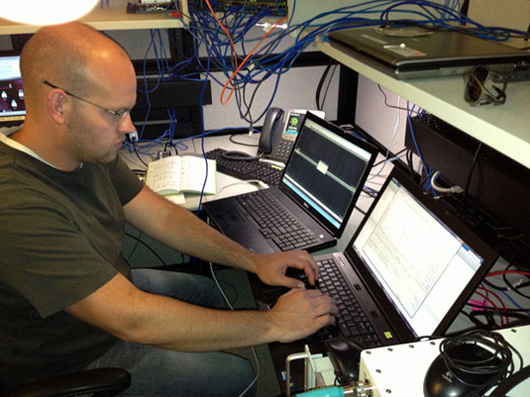Exploring Spectrum Sharing Through Technical Studies
Recognizing the importance of making additional spectrum available for wireless broadband to drive innovation, expand consumer services, and promote continued economic growth, NTIA is working hard to explore new options for federal government and industry to share spectrum. The Obama Administration is committed to making available an additional 500 MHz of spectrum for commercial use this decade, and spectrum sharing will be a critical component of that effort.

NTIA/ITS engineer John Carroll using a computer-controlled measurement system to gather data on radar-to-LTE interference effects. Photo by Frank Sanders.
NTIA continues to move technical spectrum-sharing studies forward to explore better and more efficient use of spectrum. In December 2013, we completed an important building block in spectrum sharing by publishing test results that show the extent to which radar signals can have effects on broadband Long Term Evolution (LTE) receivers. NTIA Technical Report TR-14-499, “Effects of Radar Interference on LTE Base Station Receiver Performance,” describes the methodology and results of a series of tests designed to reveal the impact of radar transmissions on 4G LTE receivers when both are operating in the same band. Another significant contribution to this discussion is the recently published report by Mike Cotton and Roger Dalke of ITS, "Spectrum Occupancy Measurements of the 3550-3650 Megahertz Maritime Radar Band Near San Diego, California."
In December 2012, the Federal Communications Commission (FCC) issued a Notice of Proposed Rulemaking (NPRM) regarding possible future spectrum sharing between radar and non-radar systems in the 3550–3650 MHz band. The NPRM called for tests and measurements to investigate the compatibility of broadband communications systems and incumbent federal radars operating in that band. In response, personnel from NTIA’s Office of Spectrum Management (OSM) and Institute for Telecommunication Sciences (ITS) performed a series of tests to assess the effects of pulsed radar signals on the performance of a 4G LTE base station. The tests were performed in collaboration with a carrier, in an isolated test bed with diagnostic software running in the background to collect data on the LTE receiver’s performance.
Two of the authors of the NTIA report on the effects of radar interference will participate in an FCC public-forum workshop in Washington, DC, on January 14 on the topic of possible future spectrum sharing at 3.5 GHz. Frank Sanders of ITS will present a talk on the test and measurement results described in their new report, and Bob Sole of OSM will moderate a discussion panel. The 3.5 GHz Spectrum Access System (SAS) Workshop will be an open meeting accessible in streaming format on the FCC's website (http://www.fcc.gov).
The testing reported in the report is an important first step towards developing feasible sharing scenarios in this band, but it is only a first step. The methodology was designed to produce information about interference effects of various radar waveforms on LTE receivers on a general rather than on a system-specific basis. Collateral factors such as radio propagation, antenna performance, environmental noise or extraneous signals from other radio systems were not studied. These aspects of the wireless signal environments might well affect actual 3.5 GHz spectrum sharing, and other studies are needed to assess potential LTE performance degradation that might arise from them. The reported tests showed that different effects can happen in the presence of radar signals, but NTIA has not yet investigated why or how the effects are different. Some radar waveforms had a drastic effect on the data and caused the link to crash, some radar waveforms had moderate effects, and a few radar waveforms had no effect.
NTIA looks to the 4G LTE Industry to assist in analyzing the data and the results, and perhaps performing additional tests. As a first step, experiments need to be designed to test the authors’ hypothesis that similar tests on a micro-cell LTE system will yield similar results. We need to increase our understanding of LTE signal detection and processing and perform additional theoretical analysis to better understand why various radar interference waveforms have particular effects.
